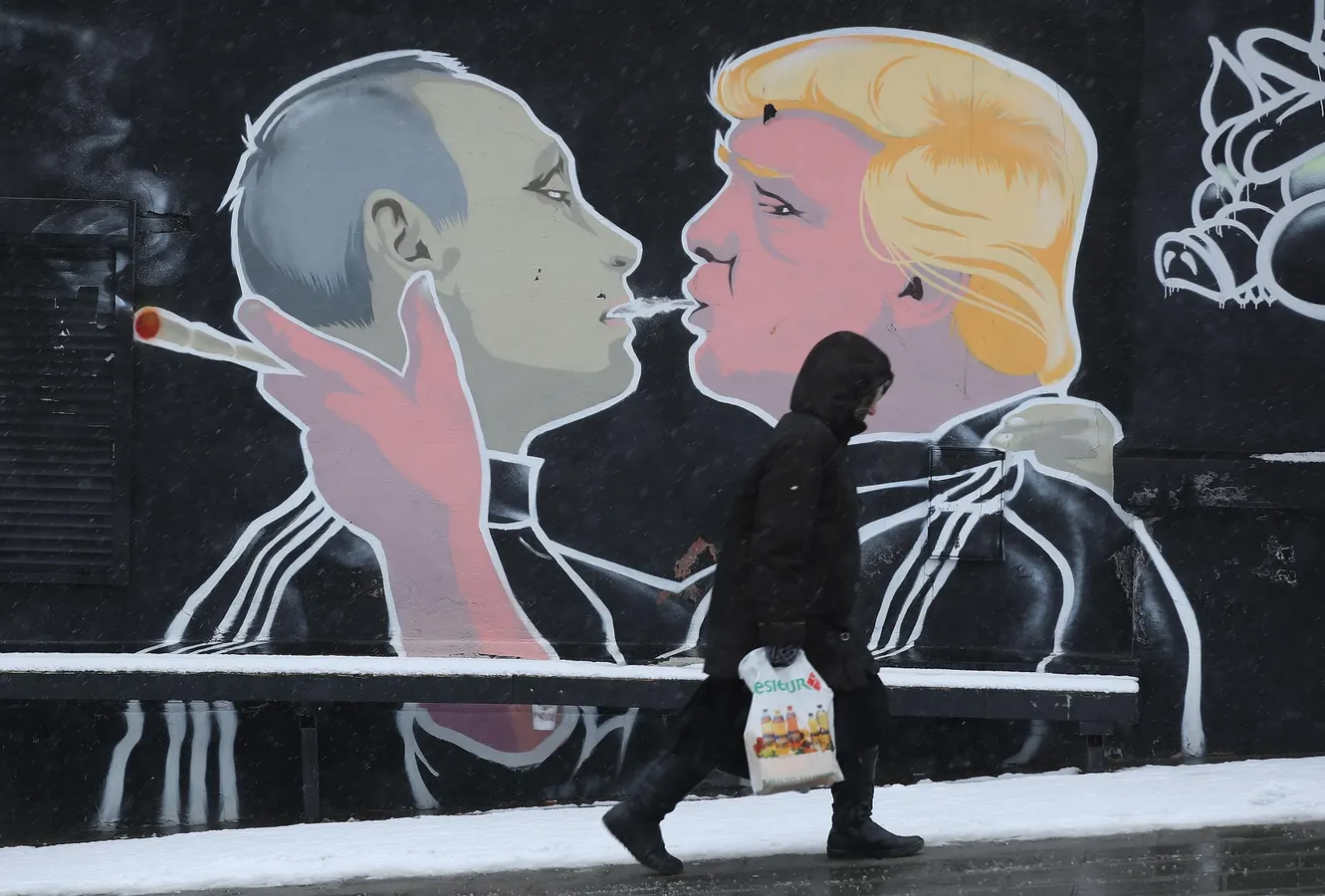By Contributor,Robert Hoban,Sean Gallup
Copyright forbes

VILNIUS, LITHUANIA – FEBRUARY 17: A mural depicts U.S. President Donald Trump (R) blowing marijuana smoke into the mouth of Russian President Vladimir Putin on the wall of a bar-b-que restaurant on February 17, 2018 in Vilnius, Lithuania. Trump has on numerous occasions expressed admiration for Putin. (Photo by Sean Gallup/Getty Images)
Getty Images
Part 2 of 3:
This article is the second installment in a three-part series examining the implications of federal cannabis rescheduling. In Part I, we explored the immediate compliance realities for existing operators — the nuts and bolts of how rescheduling could alter day-to-day operations. We set the stage by acknowledging that while rescheduling offers long-awaited recognition, it also brings heightened scrutiny and regulatory complexity.
Now, in Part II, we turn our focus outward. We look beyond the initial compliance questions and consider the broader opportunities and limitations rescheduling creates. From the myth of Big Pharma dominance to the persistence of state-based markets, from the potential for DEA registration to the opening of global trade lanes, this piece examines how rescheduling could shape the cannabis industry’s future in the U.S. and abroad. If Part I was about the ground beneath our feet, Part II is about the horizon ahead — the chance to see through new eyes what this shift truly means as we wake up to find out that we are the eyes of the world.
A photograph shows the Swiss pharma giant Roche headquarters in Basel on September 28, 2021. – Founded by Fritz Hoffmann-La Roche in 1896, Roche employs now more than 100,000 people and generates annual sales of almost 60 billion Swiss francs, becoming one of the world’s largest pharmaceutical groups. (Photo by SEBASTIEN BOZON / AFP) (Photo by SEBASTIEN BOZON/AFP via Getty Images)
AFP via Getty Images
The Big Pharma Myth
Let’s begin by puncturing a myth: that Big Pharma is salivating to swallow the cannabis industry whole once rescheduling opens the door. The narrative is seductive — massive pharmaceutical companies, armed with compliance departments and bottomless capital, swoop in to erase decades of grassroots entrepreneurship.
But that’s not how this song plays. Pharma doesn’t want to sell flower in a jar or gummies at a dispensary counter. Their comfort zone is in FDA-approved products which are designed for a specific condition, standardized dosages, and clinical distribution networks. Owning retail shops on Main Street is not their game, and never has been.
MORE FOR YOU
They will enter — but at the level of pharmaceutical-grade extracts, patented formulations, and clinical applications. The highly curated flowers, the artisanal edibles, the live resin carts, the wellness tinctures? Those will remain the domain of the existing cannabis sector — provided it can adapt.
So don’t expect Roche to start buying up your neighborhood dispensaries. Expect them instead to craft the next Epidiolex, the next standardized cannabinoid therapy. Pharma wants science, patents, and insurance coverage — not the headache of managing state-level retail operations.
Even with rescheduling and the pharmaceutical industry entering the space, it would be nearly impossible for pharma to simply shut down state-licensed dispensaries. These retail systems are deeply entrenched, with billions in tax revenue, thousands of jobs, and strong political support at the state level. Legislators and governors have little incentive to dismantle programs that fund schools, public health, and infrastructure, especially when public opinion overwhelmingly favors access. Pharma may dominate the FDA-regulated lane, but dispensaries will continue to thrive in their own parallel lane, protected not only by economics and politics but also by the consumer demand that built them in the first place. This is especially true given that it is unlikely that States will shut down their existing systems.
This map shows the countries where recreational cannabis use is allowed as of April 2024, based on data from Wikipedia. Data source: Wikipedia. (Graphic by Visual Capitalist via Getty Images)
Getty Images
States Will Not Surrender Their Systems
Federal rescheduling does not bulldoze the patchwork of state cannabis markets. Governors and legislatures have tied their economic fortunes to cannabis revenue. Entire state budgets are buoyed by excise taxes. Local economies are sustained by cultivation jobs and retail employment. Politically, dismantling those systems would be suicidal.
So let’s be clear: even if DEA reschedules, states will not shut down their dispensaries; not anytime soon. They will not turn off the tax faucet. They will double down on their autonomy — just as they have done with alcohol, gaming, and other regulated industries. State sovereignty is a stubborn fact, and cannabis has been woven into that fabric.
This means we could see a bifurcated reality: DEA-registered facilities producing Schedule III cannabis for clinical and international trade, alongside state-based systems humming along under their own rules, technically still outside federal law. A dance between parallel universes, sharing the same stage.
A logo reading DEA Special Agent is pictured in the Office of the US Drug Enforcement Administration (DEA) on May 29, 2019 in New York City. (Photo by Johannes EISELE / AFP) (Photo by JOHANNES EISELE/AFP via Getty Images)
AFP via Getty Images
DEA Registration: Who Can Adapt?
If cannabis shifts to Schedule III, any operator who wants to play in that arena must register with the DEA. But not every operator will be able to — or even want to.
The easiest candidates for registration: cultivators and manufacturers. Why? Because they are already closer to the kind of GMP, security, and record keeping standards the DEA requires. Cultivation sites can be fortified and audited. Manufacturing facilities can adopt pharmaceutical-grade SOPs.
The hardest fit: dispensaries. The DEA has never licensed retail distribution of controlled substances outside the pharmacy framework. Translating dispensaries into that model would require a regulatory imagination the agency has never demonstrated. More likely, dispensaries will remain outside the DEA orbit, protected by state law but excluded from Schedule III legitimacy.
For operators looking to prepare for the potential realities of federal rescheduling, a proactive strategy is essential. That begins with investing in facility security and inventory controls that mirror pharmaceutical operations, ensuring that every gram is tracked and safeguarded. Equally important is implementing GMP-compliant manufacturing processes, which will likely serve as the baseline standard under DEA oversight. Operators should also build robust chain-of-custody documentation systems to satisfy regulators and instill confidence with partners. Finally, now is the time to begin cultivating relationships with research institutions and clinical trial networks, laying the groundwork for participation in the next phase of cannabis as a recognized medical product.
The operators who prepare now will be first in line if the DEA opens the door. Those who assume business as usual may find themselves sidelined. I strongly encourage that each licensee take steps toward Schedule III preparedness NOW. I have been preparing legal and consulting clients for the possibility of rescheduling since 2010; the tools and pathway exist. The rules already exist if this is the scheduling change that comes. There is no reason to wait under the premise that there will be a wholly new package of rules. No matter what happens the standards and rules already exist, and businesses must adapt.
WASHINGTON, DC – APRIL 15: The Internal Revenue Service (IRS) building stands on April 15, 2019 in Washington, DC. April 15 is the deadline in the United States for residents to file their income tax returns. (Photo by Zach Gibson/Getty Images)
Getty Images
Relief and Restriction: 280E and Beyond
Rescheduling delivers the sweetest carrot cannabis operators have ever imagined: relief from Section 280E. For decades, this provision of the Internal Revenue Code has hung like an albatross around the industry’s neck, forcing companies to pay effective tax rates of 60 to 70 percent. By treating cannabis operators like traffickers of illicit drugs, 280E denied them the most basic deductions for payroll, rent, marketing, and other ordinary business expenses. In a sector already operating on razor-thin margins, the policy effectively punished compliance and rewarded only those willing to cut corners.
The end of 280E under Schedule III status would be transformative. Suddenly, cannabis businesses could reinvest in staff, expand facilities, upgrade compliance systems, and engage in brand-building efforts once considered luxuries. Tax equity levels the playing field and signals to investors that cannabis companies are no longer radioactive in the eyes of the IRS. For many, this shift alone could be the difference between insolvency and sustainable growth.
Yet the relief comes tethered to a heavy leash. Under Schedule III, cannabis distribution must occur only between DEA registrants or their international equivalents. This means that sales cannot simply flow to any operator holding a state-issued license, as is the norm today. Instead, only those who successfully register with the DEA — and comply with its rigorous pharmaceutical-style oversight — will be legitimate trading partners. For existing operators, this could shrink their addressable market overnight, locking out many long-standing customers who are either unwilling or unable to make the leap into the DEA system. No one knows how this will shake out in a conflicting system where states and the federal government have divergent licensing systems, but it will be a major issue going forward – Who can I sell to?
And while the 280 tax relief will likely apply to all cannabis sellers (regardless of DEA registration status), it presents an interesting paradox — newfound financial freedom but fewer eligible customers — and this defines the rescheduling era’s most immediate tension. Businesses may finally enjoy tax relief, yet find themselves in a vastly different, more competitive, more restricted commercial ecosystem. For operators accustomed to the broad reach of state-based markets, this adjustment will feel less like liberation and more like recalibration.
Moreover, these restrictions will test the industry’s adaptability. Those who choose to pivot; securing DEA registration and aligning their operations with pharmaceutical standards, will gain access to a narrower, but more stable and globally integrated supply chain. Those who resist or delay may continue to operate under state systems, but without the federal protections and tax benefits now available. In this bifurcated landscape, agility, foresight, and compliance readiness will separate the survivors from the casualties.
Ultimately, rescheduling creates a classic push-pull dynamic. The financial shackles of 280E fall away, unlocking the potential for growth and investment. At the same time, the Schedule III market contracts into a DEA-defined ecosystem that many are unprepared to enter. The industry’s next chapter will be written in how operators navigate this contradiction — balancing relief with restriction, freedom with limitation, opportunity with reality.
Price Dynamics: Risk and Reward
Cannabis pricing has always been a story of risk. When risk is high, prices soar. When risk falls, so do margins. Rescheduling will reduce certain risks — tax exposure, banking exclusion, investment hesitation. As a result, prices will likely fall, particularly in wholesale markets.
But reduced risk also opens access to scale, efficiency, and institutional capital. Margins may shrink, but the pie itself gets larger. For operators who can achieve economies of scale and compliance excellence, profitability remains possible, even in a lower-price environment.
Think of it as the difference between a garage band and an arena tour. The intimacy may fade, but the audience is bigger, and the business is sustainable. I will elaborate on this concept in Part III.
CHICAGO, IL – AUGUST 24: A trader monitors offers in the Standard & Poor’s 500 stock index options pit at the Chicago Board Options Exchange (CBOE) on August 24, 2015 in Chicago, Illinois. Uncertainty among traders after big losses in the Asian markets caused a sharp drop in the S&P at the open. (Photo by Scott Olson/Getty Images)
Getty Images
Banking, Capital, and Investment
The financial implications of rescheduling are massive. Banks that once feared Schedule I entanglement will find more comfort under Schedule III. Institutional investors, long hesitant, will see reduced legal risk. Capital markets could reopen to cannabis operators, enabling: Lines of credit and traditional loans; access to major exchanges for public listings’; and, M&A activity driven by consolidation and scale.
But investors will not blindly throw money again, or will they? It is more likely this time around that they will demand compliance, transparency, and credible growth strategies. The era of hype-driven valuations seems to be over. In its place: disciplined capital, cautious optimism, and a bias toward operators who can navigate both state systems and federal requirements.
IAEA flag flatters in the wind in front of the International Atomic Energy Agency headquarers in UN city in Vienna, 15 November 2004. Iran has agreed to fully suspend uranium enrichment activities as of November 22, the UN atomic energy agency said Monday in a key report that also cleared Tehran of diverting nuclear material for weapons. (Photo by Joe KLAMAR / AFP) (Photo by JOE KLAMAR/AFP via Getty Images)
AFP via Getty Images
The UN and International Alignment
In 2020, the United Nations formally recognized the medical value of cannabis by removing it from the strictest category of global control. The United States supported that change. Rescheduling at home now aligns U.S. law with that global posture. It signals consistency, credibility, and willingness to participate in international norms.
This alignment matters. International trade in controlled substances requires compliance with UN treaties. A Schedule III designation brings the U.S. into harmony with the system that governs morphine, codeine, and other widely traded medical substances. For global cannabis, this is a milestone.
A Global Opportunity
If there is one arena where rescheduling unlocks profound opportunity, it is the global cannabis trade. For years, the United States — the birthplace of the modern cannabis reform movement — has been forced to sit on the sidelines, a reluctant observer while other nations build export empires. Canada, with its federally legal framework, has turned itself into the OPEC of medical cannabis, shipping product to Israel, Australia, and Europe. Colombia has leveraged climate and low-cost cultivation to position itself as a global supplier. Germany, by embracing pharmaceutical-grade imports, has become the EU’s cannabis distribution hub. Meanwhile, aside from hemp operators, U.S. cannabis operators have been locked out, shackled by Schedule I. It’s like watching your bandmates tour the world while you’re still grounded at home.
Rescheduling to Schedule III changes that dynamic in a heartbeat. A U.S. cultivator or manufacturer, armed with DEA registration, could finally ship cannabis across borders — provided the exports align with international treaty obligations. This is not abstract; it’s the opening riff of a song the rest of the world has been jamming on for years. The U.S. suddenly has the chance to plug into the global cannabis supply chain, to trade not just domestically but with partners in Germany, Israel, Australia, and beyond. Imagine American-grown cannabis sitting on pharmacy shelves in Frankfurt or Tel Aviv, labeled with DEA compliance, recognized as medicine. For the first time, the phrase “Made in the USA” could apply to legal cannabis on a global stage.
And the world is legalizing — fast. Thailand has moved from prohibition to medical access. Portugal, once the face of decriminalization, is edging into regulated frameworks. South Africa and Lesotho are pairing traditional cultivation with modern compliance to create export channels. Argentina, Brazil, and others in Latin America are scaling medical programs with an eye on exports. Each country’s model reflects local politics and priorities, but the trend line is unmistakable: medical cannabis is going mainstream worldwide. The U.S., by stepping into Schedule III, gains a ticket to join the caravan.
But here’s the rub: the global trade isn’t forgiving. This isn’t the easygoing vibe of a Saturday afternoon dispensary. It’s medical, pharmaceutical-grade, highly scrutinized, and unforgiving of missteps. U.S. operators who want in will need GMP+ certification, chain-of-custody systems, and ironclad compliance — not the patchwork improvisation that has defined much of the American state market. Think Zeppelin rather than the Dead: precision, power, and structure, not free-form jamming. The opportunity is massive, but the discipline required will weed out the unserious players.
For those ready to adapt, the horizon is wide open. International exports could be the great equalizer — shifting U.S. cannabis from a fragmented, state-bound market into a global industry where scale, quality, and compliance drive success. The risk is real, the costs are high, and the learning curve is steep. But the reward is historic: finally seeing American cannabis not as a parochial state experiment but as a global commodity, traded alongside wine, coffee, and pharmaceuticals. Once in a while you get shown the light — and for U.S. cannabis operators, rescheduling might just be the moment when the light reveals the world.
Lessons from Abroad
I recently wrote a piece outlining what the U.S. can learn from global cannabis operators –
ForbesCase Studies In International Cannabis: What The World Can Teach UsBy Robert Hoban
Look to Canada: federal legalization created a short-term boom, followed by oversupply and market correction. Look to Germany: medical access has been cautious but steady, with reimbursement driving real demand. Look to Colombia and Morocco: cultivation-for-export models showcase the agricultural potential of cannabis.
The U.S. can learn from each of these stories. Rescheduling gives it the chance to enter the global stage not as a pioneer, but as a strategic participant, leveraging scale, innovation, and brand power.
Four Policy Lanes: A Quick Reminder
The cannabis policy conversation has always run down distinct parallel Policy Lanes. These are distinct regulatory pathways that already exist and can be applied to cannabis without inventing an entirely new legal framework. Crafting comprehensive new cannabis legislation is politically difficult and time-consuming. Instead, rescheduling will push policymakers and operators to rely on these lanes, each with its own rules, regulators, and market dynamics.
These Five Policy Lanes are: (1) over-the-counter/adult-use cannabis; (2) general-use medical and pharmaceutical cannabis; (3) wellness and food products/nutraceuticals; (4) industrial hemp applications; and (5) the illicit market. Each lane has its own infrastructure, precedents, and oversight mechanisms — from FDA drug approval to USDA hemp standards — that already shape how cannabis is produced, processed, and consumed.
Rescheduling, in practice, lands squarely in Lane Two by validating pharmaceutical cannabis. It unlocks FDA pathways, clinical trials, and insurance coverage for cannabinoid-based medicines. But the other lanes don’t disappear. Hemp remains a federally legal crop. Adult-use cannabis still lives under state law. Nutraceuticals and wellness products continue to navigate FDA and USDA oversight. And the illicit market persists as both a competitor and a pressure valve until legal access expands broadly enough to undercut it.
The takeaway is that rescheduling reframes, rather than replaces, these existing lanes. They will intersect, overlap, and compete in new ways, and the success of the cannabis industry will depend on how well operators, regulators, and investors understand the unique opportunities and risks within each. The Five Policy Lanes are not just a framework for today — they are the map for navigating the post-rescheduling landscape.
The lanes continue to coexist — sometimes in harmony, often in tension. Rescheduling doesn’t consolidate them. It reframes their intersections.
Vintage illustration of a 1950s businessman with a crystal ball, telling the fortune of his company’s profits, 1953. (Illustration by GraphicaArtis/Getty Images)
Getty Images
The Next Five to Ten Years
Here’s what to watch as cannabis moves into a rescheduled reality. First, the pharmaceutical footprint will expand rapidly. Cannabinoid-based therapeutics, from isolated compounds to complex formulations, are poised to flood the research and development pipeline. Drug companies — both established giants and nimble biotech startups — see an open lane to pursue FDA approval for cannabis-derived medicines. The shift promises new treatments and broader patient access, but it also raises questions about whether traditional cannabis operators can compete in an arena dominated by big pharma’s scale, precision, and lobbying power.
At the same time, the uneasy coexistence of two systems will define the next decade. On one hand, the DEA-registered ecosystem will operate under federal oversight, with all the rigor of pharmaceutical supply chains. On the other hand, state-licensed markets — the familiar dispensaries and cultivators — will continue to function under local rules. This duality creates friction. Transactions permissible in one system may be prohibited in the other, leaving operators to navigate a patchwork of compliance that could rival, or even surpass, the complexity of today’s state-by-state system.
The global trade dynamic adds another layer of pressure. U.S. operators, newly empowered to participate in exports, will push to access foreign markets. Meanwhile, international buyers — from German distributors to Israeli clinics — will demand entry into the American system. The resulting push and pull will test the limits of U.S. regulators, who must balance treaty obligations, domestic interests, and the realities of a rapidly globalizing cannabis economy.
All of this will reshape the investment landscape. The “green rush” era of easy money and loose discipline is gone. Investors now demand professionalism, compliance, and predictable performance. While capital will flow into the sector, it will do so with sharper pencils, tighter diligence, and little patience for operators who can’t meet pharmaceutical or export-grade standards.
Finally, pricing will evolve as cannabis edges closer to behaving like an agricultural commodity. Once risk premiums decline and production scales under GMP conditions, prices will settle into more stable ranges — not the wild swings of today’s fragmented markets. For consumers and patients, this may mean more affordable and consistent access. For operators, it signals a new competitive environment where efficiency, quality, and compliance determine survival.
The wheel is turning, and the rhythm is accelerating.
Closing Reflections
I have traveled the globe for almost twenty years assisting in the development of cannabis policies (for over thirty-five countries) and in the ongoing construction of the global cannabis supply chain. Travel changes perspective. It humbles, educates, and exposes contradictions. Cannabis reform is no different. Walk through a dispensary in Denver, a pharmacy in Berlin, a co-op farm in Colombia, or a clinic in Tel Aviv. Each tells a story of cannabis as medicine, as commerce, as culture.
Rescheduling could be that strange light: a flash of validation after decades of shadow. But it is not the end of the journey. It is a beginning. The challenge for operators, policymakers, and consumers is to see clearly — to recognize both the opportunities and the constraints, and to navigate them with honesty, discipline, and imagination.
And perhaps, to borrow a Zeppelin whisper: “There are two paths you can go by, but in the long run, there’s still time to change the road you’re on.”
Cannabis in America has reached that fork. The eyes of the world are watching.
Looking Ahead to Part III
This is only the middle movement of the song. Part III of this series will step further into the unknown: examining the possible chaos that results from rescheduling and, more importantly, looking closely at what full de-scheduling could mean, how federal legalization might finally harmonize with state systems, and what a truly global cannabis economy could look like with the U.S. as a full participant. If Part I laid the groundwork and Part II opened the horizon, Part III will explore the next verse —whether the industry is ready to play in tune with history.
Editorial StandardsReprints & Permissions



